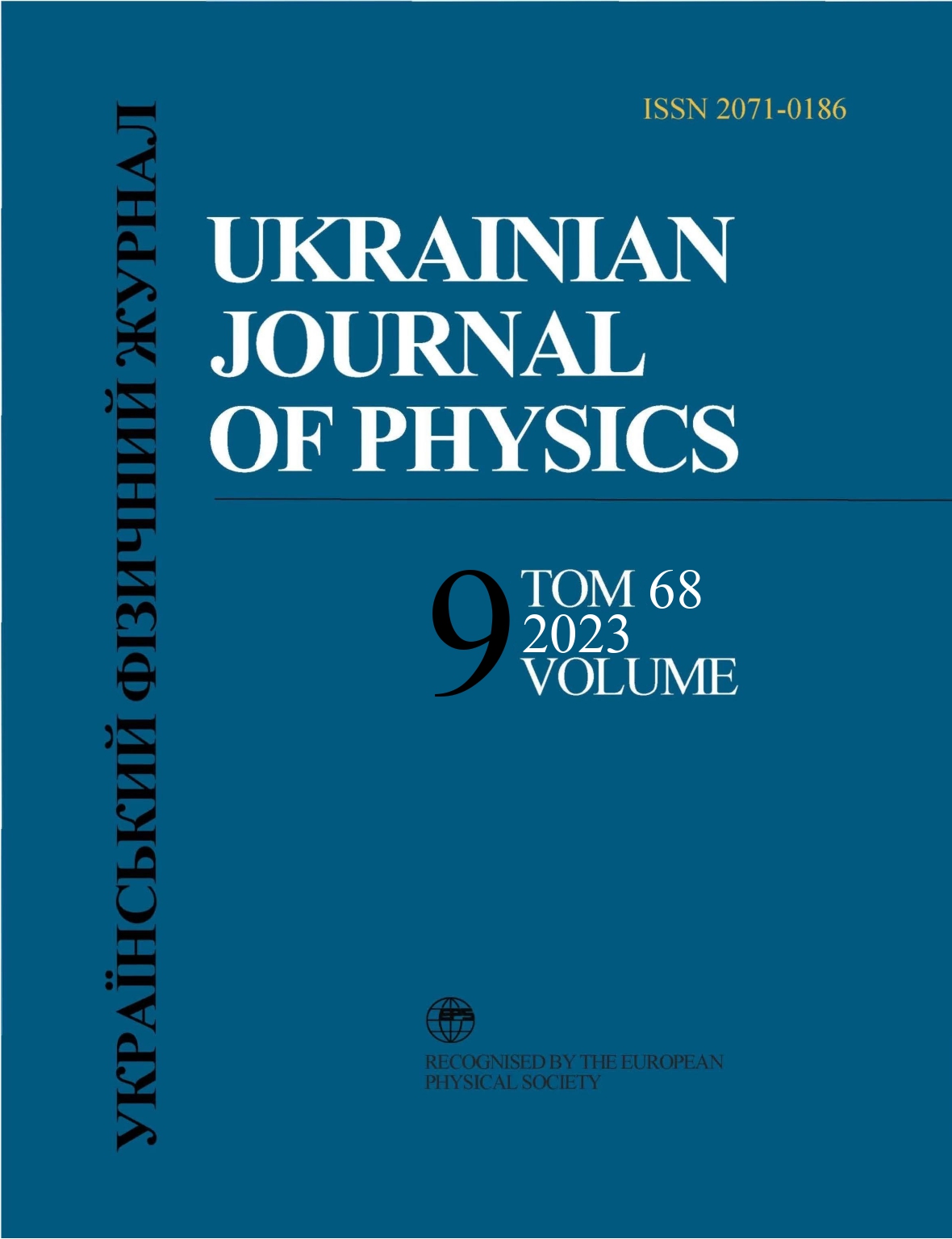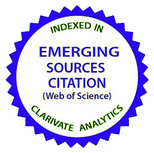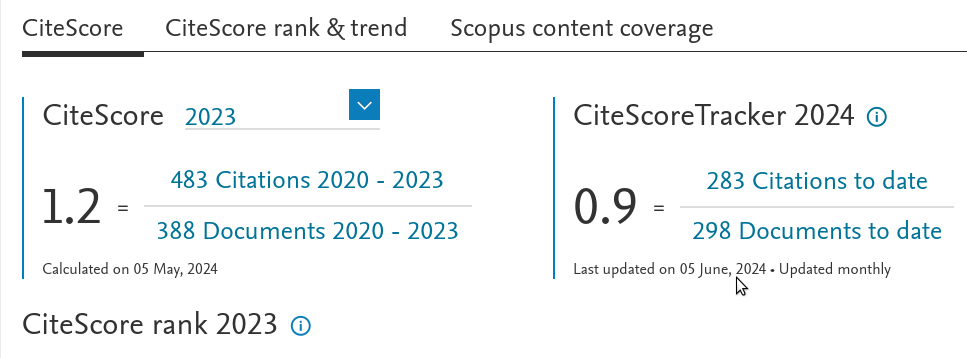Synthesis and Characterization of a Novel Nanocomposite Polymer
DOI:
https://doi.org/10.15407/ujpe68.9.638Keywords:
nanocomposite, thin films, polyaniline, dye, PVAAbstract
One-dimensional nanostructures of PANI: PVA-g-EI nanocomposite are prepared by the interfacial polymerization method. The properties of a resulting green powder are studied by the X-ray diffraction (XRD), energy-dispersive X-ray analysis (EDX), transmission electron microscopy (TEM), and infrared spectroscopy (FTIR). Prepared thin films were characterized by UV-Vis and photoluminescence (PL) spectroscopies. The XRD pattern of the nanocomposite shows that the higher volume fraction of crystalline phases corresponds to the PANI polymer with the accepted monoclinic unit cell of PVA. Nano-sized irregular particles arranged in clusters appear in the TEM measurements and SEM images, which testifies to the agglomeration without uniform packing. EDX confirms that the PVA-g-EI is incorporated in the structure of the polymer nanocomposite. A significant shift in the absorption edge with three PL independent emission peaks again confirms that PANI/PVA-g-EI form a nanocomposite.
References
K. Namsheer, S.R. Chandra. Conducting polymers: a comprehensive review on recent advances in synthesis, properties and applications. RSC Adv. 11, 5659 (2021).
https://doi.org/10.1039/D0RA07800J
C.S. Markus, S.S. Niyazi. Low band gap conjugated semiconducting polymers. Adv. Mater. Technol. 6, 2000857 (2021).
https://doi.org/10.1002/admt.202000857
L. Thanh-Hai, K. Yukyung, Y. Hyeonseok. Electrical and electrochemical properties of conducting polymers. Polymers 9, 150 (2017).
https://doi.org/10.3390/polym9040150
Y.C. Kuan, I. Giuliana, A.F. Mariana. Emerging Materials for Energy Conversion and Storage (Elsevier Inc., 2018).
B. Mahnoush, A.R. Suraya, S. Suhaidi, R.S. Amir, N.L. Hong. Preparations, properties, and applications of polyaniline and polyaniline thin films - A review. Polymers 13, 2003 (2021).
https://doi.org/10.3390/polym13122003
M. Jaymand. Recent progress in chemical modification of polyaniline. Prog. Polym. Sci. 38, 1287 (2013).
https://doi.org/10.1016/j.progpolymsci.2013.05.015
G.G. Liao. Preparation of sulfonated polystyrene/polyaniline/silver composites with enhanced anticorrosive properties. Int. J. Chem. 10, 81 (2018).
https://doi.org/10.5539/ijc.v10n1p81
K. Fatemeh, M.N. Seyed, Z. Yasser, Y.R. Kyong. Biosensing applications of polyaniline (PANI)-based nanocomposites: A review. Polymer Reviw. 61, 553 (2021).
https://doi.org/10.1080/15583724.2020.1858871
P.S. Khiew N.M. Huang, S. Radiman, M.S. Ahmad. Synthesis and haracterization of conducting polyaniline-coated cadmium sulphide nanocomposites in reverse microemulsion. Mater. Lett. 58, 516 (2020).
https://doi.org/10.1016/S0167-577X(03)00537-8
H.L.F. Eduardo, W.M. Azevado. Polyaniline-poly (vinyl alcohol) composite as an optical recording material. Synth. Met. 28, 149 (2002).
https://doi.org/10.1016/S0379-6779(01)00659-2
W. Jingjing, C. Hang, Z. Anan, Z. Renhao, B. Hua, Z. Tongyi. Facile synthesis of multi-functional elastic polyaniline/polyvinyl alcohol composite gels by a solution assembly method, RSC. Adv. 10, 22019 (2020).
https://doi.org/10.1039/D0RA02238A
N.M. Tatiana, N.S. Eugeniya, A.M. Tatiana, Maria. Preparation and electrochemical characterization of PANI/PVA and PANI/Zr/PVA composites for supercapacitor application. Adv. Mater. Lett. 7, 441 (2016).
https://doi.org/10.5185/amlett.2016.6074
A. Amir. A review of dye incorporated conducting polymers application as sensors and in solar cells. Mater. Sci. Forum 657, 208 (2010).
https://doi.org/10.4028/www.scientific.net/MSF.657.208
Q.A. Ali, A. Shawi, A.H. Harith. Calculation of some electrical properties of poly vinyl alcohol grafted with eosin dye (PVA-g-Ei). J. Basrah Res. Sci. 35, 33 (2009).
J.A. Saeed, R. Mamta, S.K. Tripathi. Preparation and characterization of nanocomposite between poly (anilineco-m-chloroaniline)-copper sulfide nanoparticles. Phys. B 443, 107 (2014).
https://doi.org/10.1016/j.physb.2014.02.025
J. Bhadra, N.K. Madi, N.J. Al-Thani, M.A. Al-Maadeed. Polyaniline/polyvinyl alcohol nanocomposites: Effect of sulfonic acid dopants on microstructural, optical, thermal and electrical properties. Synth. Met. 191, 126 (2014).
https://doi.org/10.1016/j.synthmet.2014.03.003
A. Fattoum, Z.B. Othman, M. Arous. Dc and Ac conductivity of polyaniline/poly (methyl methacrylathe) nanocomposite below the percolation threshold. Mater. Chem. Phys. 135, 17 (2012).
https://doi.org/10.1016/j.matchemphys.2012.04.033
E. Dmitrieva, L. Dunsch. How linear is "linear" polyaniline. J. Phy. Chem. B 115, 6401 (2011).
https://doi.org/10.1021/jp200599f
S. Padmapriya, S. Harinipriya, V. Sudha, D. Kumar, S.P.B. Chaubey. Polyaniline coated copper for hydrogen storage and evolution in alkaline medium. Int. J. Hydrogen Energy 42, 20453 (2017).
https://doi.org/10.1016/j.ijhydene.2017.06.204
S. Bhadra, D. Khastgir. Determination of crystal structure of polyaniline and substituted polyanilines through powder X-ray diffraction analysis. Polym. Test. 27, 851 (2008).
https://doi.org/10.1016/j.polymertesting.2008.07.002
S. Padmapriya, S. Harinipriya, K. Jaidev, V. Sudha, D. Kumar, S. Pal. Storage and evolution of hydrogen in acidic medium by polyaniline. Int. J. Energy Res. 42, 1196 (2017).
https://doi.org/10.1002/er.3920
B.D. Cullity, S.R. Stock. Elements of X-Ray Diffraction (Pearson Education Limited, 2014).
B.S. Singu, P. Srinivasan, S. Pabba. Benzoyl peroxide oxidation route to nano form polyaniline salt containing dual dopants for pseudocapacitor. J. Electrochem. Soc. 159, A6 (2012).
https://doi.org/10.1149/2.036201jes
H. Xia, Q. Wang. Synthesis and characterization of conductive polyaniline nanoparticles through ultrasonic assisted inverse microemulsion polymerization. J. Nanopart. Res. 3, 399 (2001).
M. Cabuka, B. G¨und¨uz. Controlling the optical properties of polyaniline doped by boric acid particles by changing their doping agent and initiator concentration. Appl. Surf. Sci. 424, 345 (2017).
https://doi.org/10.1016/j.apsusc.2017.03.010
R. Ghosh, F.C. Spano. Excitons and polarons in organic materials. Acc. Chem. Res. 53, 2201 (2020).
https://doi.org/10.1021/acs.accounts.0c00349
C. Show, C. Kuen, C. Ching, L. Hsun. White-light emission from electroluminescence diode with polyaniline as the emitting layer. Synthetic Metals 82, 207 (1996).
https://doi.org/10.1016/S0379-6779(96)03790-3
M. Sharma, D. Kaushik, R.R. Singh, R.K. Pandey. Stady of electropolymerised polyaniline films using cyclic voltammetry, atomicforce microscopy and optical spectroscopy. J. Mater. Sci. Mater. Electron 17, 537 (2006).
https://doi.org/10.1007/s10854-006-8238-9
J. Cornil, D.A. dos Santos, X. Crispin, R. Silbey, J.L. Bredas. Influence of interchain interactions on the absorption and luminescence of conjugated oligomers and polymers: A quantum-chemical characterization. J. Am. Chem. Soc. 120, 1289 (1998).
https://doi.org/10.1021/ja973761j
M.J. Hashim, M.J. Eman, Q.A. Ali. Dispersion parameters, optical constant and photoluminescence of poly vinyl alcohol grafted eosin-Y dye (PVA-g-Ei). J. Basrah Researches (Sciences) 36, 3 (2010).
Downloads
Published
How to Cite
Issue
Section
License
Copyright Agreement
License to Publish the Paper
Kyiv, Ukraine
The corresponding author and the co-authors (hereon referred to as the Author(s)) of the paper being submitted to the Ukrainian Journal of Physics (hereon referred to as the Paper) from one side and the Bogolyubov Institute for Theoretical Physics, National Academy of Sciences of Ukraine, represented by its Director (hereon referred to as the Publisher) from the other side have come to the following Agreement:
1. Subject of the Agreement.
The Author(s) grant(s) the Publisher the free non-exclusive right to use the Paper (of scientific, technical, or any other content) according to the terms and conditions defined by this Agreement.
2. The ways of using the Paper.
2.1. The Author(s) grant(s) the Publisher the right to use the Paper as follows.
2.1.1. To publish the Paper in the Ukrainian Journal of Physics (hereon referred to as the Journal) in original language and translated into English (the copy of the Paper approved by the Author(s) and the Publisher and accepted for publication is a constitutive part of this License Agreement).
2.1.2. To edit, adapt, and correct the Paper by approval of the Author(s).
2.1.3. To translate the Paper in the case when the Paper is written in a language different from that adopted in the Journal.
2.2. If the Author(s) has(ve) an intent to use the Paper in any other way, e.g., to publish the translated version of the Paper (except for the case defined by Section 2.1.3 of this Agreement), to post the full Paper or any its part on the web, to publish the Paper in any other editions, to include the Paper or any its part in other collections, anthologies, encyclopaedias, etc., the Author(s) should get a written permission from the Publisher.
3. License territory.
The Author(s) grant(s) the Publisher the right to use the Paper as regulated by sections 2.1.1–2.1.3 of this Agreement on the territory of Ukraine and to distribute the Paper as indispensable part of the Journal on the territory of Ukraine and other countries by means of subscription, sales, and free transfer to a third party.
4. Duration.
4.1. This Agreement is valid starting from the date of signature and acts for the entire period of the existence of the Journal.
5. Loyalty.
5.1. The Author(s) warrant(s) the Publisher that:
– he/she is the true author (co-author) of the Paper;
– copyright on the Paper was not transferred to any other party;
– the Paper has never been published before and will not be published in any other media before it is published by the Publisher (see also section 2.2);
– the Author(s) do(es) not violate any intellectual property right of other parties. If the Paper includes some materials of other parties, except for citations whose length is regulated by the scientific, informational, or critical character of the Paper, the use of such materials is in compliance with the regulations of the international law and the law of Ukraine.
6. Requisites and signatures of the Parties.
Publisher: Bogolyubov Institute for Theoretical Physics, National Academy of Sciences of Ukraine.
Address: Ukraine, Kyiv, Metrolohichna Str. 14-b.
Author: Electronic signature on behalf and with endorsement of all co-authors.













